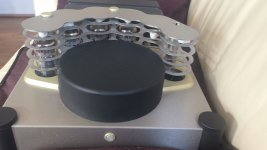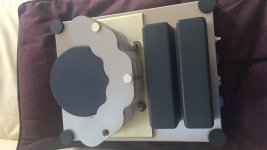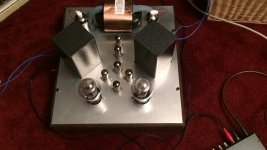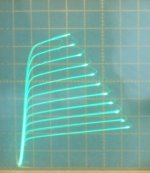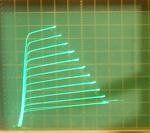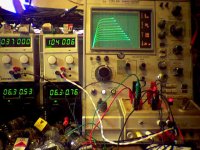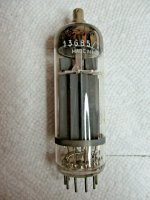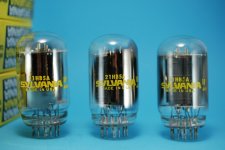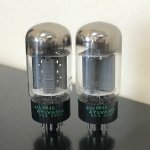if Smoking amp wants to try some PL504/27GB5 on the Tek that would help out the Europeans across the pond. as the 504 is one of the few series heater tubes i dont know what to do with. I remember putting them on my diy tester and they would go wild if you put more than 150V on G2 not sure if they where oscillating or not.
I have asked tubelab the same question in another thread.
I have asked tubelab the same question in another thread.
Sure they go wild, any tube goes wild if you offer +150V on the grid. Remember the G1 is shorted to C.
These tubes have been used in OTL amps by Graaf (16 tubes per channel). I have heard them and they sound really good. I have build OTL’s in the past using sweep tubes and found that these start oscillating (as you have found as well). I could remedy thus with ferrite beads.
Attachments
Thats a nice space heater.
If you want to play around with OTL for cheap, the 6C19 is very usefull for that. But OTL's with series regulator tubes can be harder to engineer because of grid current and leakage. So the EL504/PL504 has a slight edge over the Triode pass regulator tubes because it was made with lower leakage requirements.
I suggest a bias servo for OTL amplfiers, its just a bit harder... because everything needs to float.
6C33 Tube
If you want to play around with OTL for cheap, the 6C19 is very usefull for that. But OTL's with series regulator tubes can be harder to engineer because of grid current and leakage. So the EL504/PL504 has a slight edge over the Triode pass regulator tubes because it was made with lower leakage requirements.
I suggest a bias servo for OTL amplfiers, its just a bit harder... because everything needs to float.
6C33 Tube
Last edited:
Never used regulator tubes. Good in power supplies only ( my opinion) and even here i prefer sweep tubes (even as rectifiers and at the same time as AC voltage regulator) as done in my 300b monster.
Attachments
Last edited:
1) Single ended amps have not become more popular, the topic on single ended amps may have become more popular
2) Also "well designed" push-pull amps will display genuine push-pull characteristics
3) I-O curves say nothing about performance
4) Amen
2) Also "well designed" push-pull amps will display genuine push-pull characteristics
3) I-O curves say nothing about performance
4) Amen
smoking-amp, your explanation of roll-over is for valves designed for higher mutual conductance. What about valves such as 6L6 types which have similar gm to, say, 300B, but which still display roll-over in triode mode? Would series anode to grid feedback still help much when they don't have so much gain to trade?
Here are some curve sets for 13GB5, including g2 drive and Crazy drive. (1st pic below)
https://www.diyaudio.com/forums/tub...ariants-screen-driven-amps-3.html#post4841935
As you can see, Crazy drive takes less drive voltage to reach the same output due to the grid 1 assist (about 30% less drive Vg2 for 13GB5). George (Tubelab) recently commented that he gave up on g2 drive due to too many Sweep tubes biting the dust. Just takes two resistors to get from g2 drive to Crazy drive for a safer and easier drive.
But the "new" series Schade (UnSET, CED at Tubelab) can get you constant Mu with low grid 1 voltages. This gives you low output Z, which Crazy drive doesn't have (needs N Fdbk around it).
Unfortunately, the above linked 13GB5 g2 drive curve set didn't get traced down to low V. That may have been before I did the 2nd mod to the 576 tracer to get 170V stepping for grid 2 plots. ( from 60V stepping for the 1st mod, would have used a 50V series fixed supply to reach 110V back then)
13GB5 is almost identical with 21HB5A for curves. And 21HB5A doesn't have any plate cap. (and the Chinese plate caps for 13GB5 just fall off besides)
Here are the 21HB5A grid 2 curves with probably the same 110V max g2 V (2nd pic below).
I think George has mentioned using 6L6 type tubes with UnSET/CED successfully. I don't know why 6L6 has the roll-over with lower gm, but I guess the manufacturers weren't too concerned about triode curves back then.
https://www.diyaudio.com/forums/tub...ariants-screen-driven-amps-3.html#post4841935
As you can see, Crazy drive takes less drive voltage to reach the same output due to the grid 1 assist (about 30% less drive Vg2 for 13GB5). George (Tubelab) recently commented that he gave up on g2 drive due to too many Sweep tubes biting the dust. Just takes two resistors to get from g2 drive to Crazy drive for a safer and easier drive.
But the "new" series Schade (UnSET, CED at Tubelab) can get you constant Mu with low grid 1 voltages. This gives you low output Z, which Crazy drive doesn't have (needs N Fdbk around it).
Unfortunately, the above linked 13GB5 g2 drive curve set didn't get traced down to low V. That may have been before I did the 2nd mod to the 576 tracer to get 170V stepping for grid 2 plots. ( from 60V stepping for the 1st mod, would have used a 50V series fixed supply to reach 110V back then)
13GB5 is almost identical with 21HB5A for curves. And 21HB5A doesn't have any plate cap. (and the Chinese plate caps for 13GB5 just fall off besides)
Here are the 21HB5A grid 2 curves with probably the same 110V max g2 V (2nd pic below).
In the next post after the 13GB5 curves link, George mentions that ESRC sold 40,000 _GB5 tubes to some OTL maker. There may not be many of these tubes around any more. I see Graaf sells a set of 32 tubes for $500. ESRC sold them in quantity for $0.30 each.These tubes have been used in OTL amps by Graaf (16 tubes per channel).
What about valves such as 6L6 types which have similar gm to, say, 300B, but which still display roll-over in triode mode? Would series anode to grid feedback still help much when they don't have so much gain to trade?
I think George has mentioned using 6L6 type tubes with UnSET/CED successfully. I don't know why 6L6 has the roll-over with lower gm, but I guess the manufacturers weren't too concerned about triode curves back then.
Attachments
Last edited:
Just to be clear, the two curves sets above: 13GB5 and 21HB5A were both using g2 drive. (I put the 1st pic comment in the wrong place above)
Picture of the 576 curve tracer below, with 4 Xantrex supplies for the 2 screen voltages and the 2 heater voltages. The DUT toggle switch on the tracer can flip between two tubes, with different continuous heater V and automatically selected screen V for each tube.
Easy to compare dissimilar tubes like 13GB5 and 21HB5A on this.
Picture of the 576 curve tracer below, with 4 Xantrex supplies for the 2 screen voltages and the 2 heater voltages. The DUT toggle switch on the tracer can flip between two tubes, with different continuous heater V and automatically selected screen V for each tube.
Easy to compare dissimilar tubes like 13GB5 and 21HB5A on this.
Attachments
Last edited:
I am overjoyed an thoroughly impressed.
If you want to make to make a dual fixture: I think you could do it out of some rather cheap parts from the top of my head, you would have to bring out the a connection for the Y amplifier pickup to the connector. Two HCPL7800 on the high side supplied by some 1W DC/DC ,INA105 to go from differential to SE and A 555 free running at 50 % duty cycle and a HEF4066 driven by said 555 to gate the signal. my idea was to do the current measurement from two tubes simultaneously and chop at something like 100Khz
Cheers,
V4lve
If you want to make to make a dual fixture: I think you could do it out of some rather cheap parts from the top of my head, you would have to bring out the a connection for the Y amplifier pickup to the connector. Two HCPL7800 on the high side supplied by some 1W DC/DC ,INA105 to go from differential to SE and A 555 free running at 50 % duty cycle and a HEF4066 driven by said 555 to gate the signal. my idea was to do the current measurement from two tubes simultaneously and chop at something like 100Khz
Cheers,
V4lve
You could just put the tubes in parallel and flip the grid 1 voltages alternately from the step V to a very negative bias (tube shutoff).
Could do the flipping in synchronism with the sweeps.
Could do the flipping in synchronism with the sweeps.
Last edited:
There is an indirect heated version of 6A3 (forgot the name), with the same mu and gm. Does it mean that it sounds same as the DH one?
Also, 6F6 is the indirect heated version of the 47 DH pentode. A while ago, I tried both in Gary Pimm' s DC-coupled circuit, and 6F6 did not have the same finesse as 47. Gary tried 6BQ5 in his circuit, and opined that it was fine, but lacked the DH sound.
So, DH sound is not just confined to triodes, pentodes have it too.
So, DH sound is not just confined to triodes, pentodes have it too.
Last edited:
There is an indirect heated version of 6A3 (forgot the name), with the same mu and gm. Does it mean that it sounds same as the DH one?
I dont think so just because the cathode likely has far greater emission potential.
I think you are referring to the repacked sweep tube to replace 6B4G
Attachments
I looked it up: 6A5G. Data sheet says explicitly it was designed to substitute for 6B4G. Unfortunately, there is no plate characteristic graph.
There is a whole thread on this from August 2019: "power triodes indirect vs direct heating".
Most of the science is considered.
Of course, there are scarcely any indirectly heated power triodes.
Most of the science is considered.
Of course, there are scarcely any indirectly heated power triodes.
6A3 and 6A5G, both being triodes and the 6A5G claiming to be identical, one would expect they paid some attention to the curves. But, then again, they don't give any curves for the 6A5G, one does wonder. One for a curve tracer to decide.
Likely the case in pentodes too, although one typically uses N Fdbk of some kind with a pentode, so such a subtlety would generally be gone I think.
"New" series Schade (UnSET, CED) is just a local Neg. Fdbk scheme that gets rid of triode "roll-over". (except see below)
There are some clever tricks with the Schade, UnSet, CED scheme that can be added, like extending the grid 2 incidental Fdbk. It could be arranged to either increase or decrease the roll-over. (using some low % Neg. or Pos. AC phase Fdbk applied to grid 2 by a Mosfet follower.) One could even over compensate the roll-over to cancel some of the loadline/diode curves dist.
The grid 2 incidental Fdbk (grid2 V - cathode V) in series Schade/UnSET/CED is opposite in phase effectively to that of Ultralinear Fdbk. So it puts some non-linear anti-rollover effect into play because it is 3/2 power law versus the square law at the grid1-cathode input signal. Making the scheme more effective than just simple N Fdbk at fixing roll-over.
So, DH sound is not just confined to triodes, pentodes have it too.
Likely the case in pentodes too, although one typically uses N Fdbk of some kind with a pentode, so such a subtlety would generally be gone I think.
"New" series Schade (UnSET, CED) is just a local Neg. Fdbk scheme that gets rid of triode "roll-over". (except see below)
There are some clever tricks with the Schade, UnSet, CED scheme that can be added, like extending the grid 2 incidental Fdbk. It could be arranged to either increase or decrease the roll-over. (using some low % Neg. or Pos. AC phase Fdbk applied to grid 2 by a Mosfet follower.) One could even over compensate the roll-over to cancel some of the loadline/diode curves dist.
The grid 2 incidental Fdbk (grid2 V - cathode V) in series Schade/UnSET/CED is opposite in phase effectively to that of Ultralinear Fdbk. So it puts some non-linear anti-rollover effect into play because it is 3/2 power law versus the square law at the grid1-cathode input signal. Making the scheme more effective than just simple N Fdbk at fixing roll-over.
Last edited:
Of course, there are scarcely any indirectly heated power triodes.
I think i could name at least a dozen dont take me the wrong way. this is just to keep the gray mass going.. most made for series regulator use. The Soviets alone made five or six 6C18 6C19 6C41 6C33 and some shunt triodes for controlling HT in TV high voltage supplies
Theres the 12B4 6AS7G and its update the 6080, then there was the 6336 6528 and another western electric specific tube? 59xx
Telefunken made the ED8000 RFT the EC360
If you count the rest of the triodes used to regulate the HT in color tv”s theres at least 30 or so distinct part numbers that i know of. And a plethora of equivalents for some.
- Home
- Amplifiers
- Tubes / Valves
- Why has single ended output become popular
